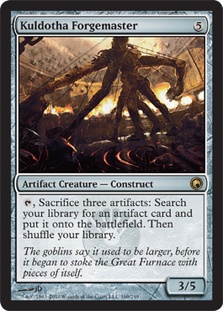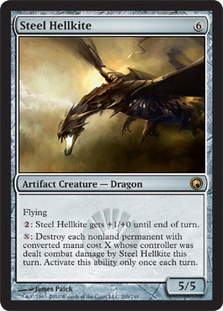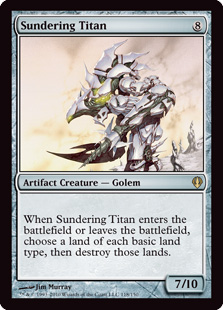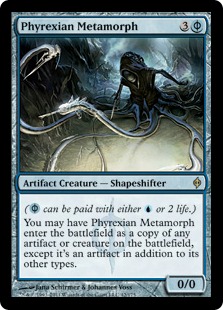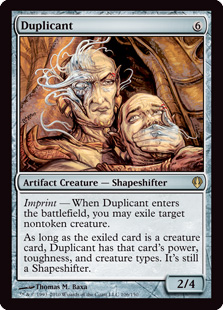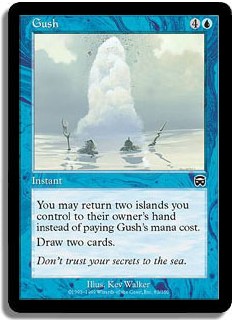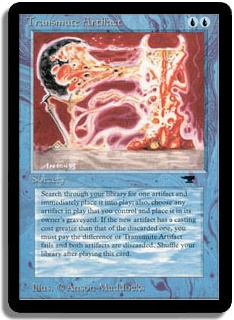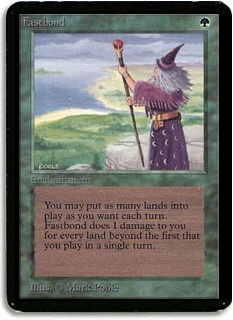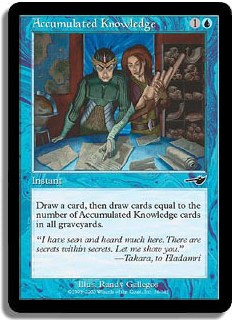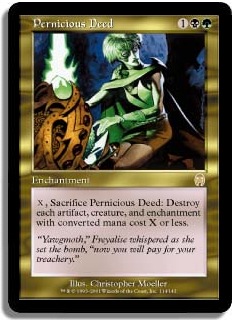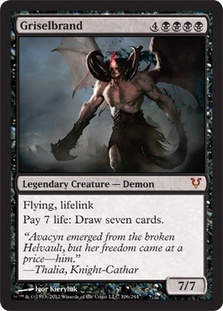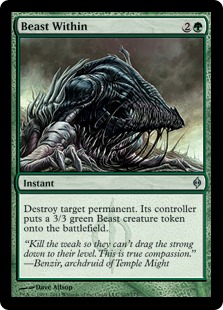Introduction
In this article we’re going to take a look at nine awesome and incredibly diverse Vintage decklists from Grudge Match V, which took place last weekend. Vintage has recently been reinvented as the new “Wild West” of tournament Magic where literally everything and anything goes. Creature decks? Check. Combo decks of several different flavors? Check. Prison decks? Check. Five-color control decks? Checkmate, in my opinion:
“Vintage currently has the most interesting and wildly diverse metagame in all of Constructed Magic.”
I’ve also got the scoop on Paul Mastriano under the radar Griselbrand Oath list that narrowly missed out on Top 8.
As aptly said by the Grudge Match’s T.O. and Vintage Master, Nick Detwiler:
“I think the diversity of the field has to be the biggest takeaway. Creatures are playing a much more important role in Vintage than they’ve ever played before (I heard remarks all day long that ‘this looks like a Legacy match’, or ‘this is Legacy with Moxen,’ etc.). Raf might have won the event, but I don’t feel like any deck truly dominated. Maybe we’re moving closer to something like Legacy; maybe there really are 10-20 tier 1-1.5 decks, and maybe we can’t really plan for a given field anymore.”
Let’s take a look at what’s going on in Magic’s oldest format!
The Decks Of The Grudge Match
The fifth Grudge Match, the first major Vintage tournament to feature cards from the Avacyn Restored expansion, took place last weekend in New York, and the results sure are interesting. In a field that appears to have been saturated with various blue decks and creature decks, once again Mishra’s Workshop stands alone as the champion at the end of the Top 8, piloted by Vintage fan favorite Raffaelle Forino.
I. The Workshop Decks (MUD, Mono-Red Shops)
Let’s take a look at the deck that won the event:
Creatures (17)
- 1 Sundering Titan
- 1 Duplicant
- 4 Lodestone Golem
- 1 Steel Hellkite
- 4 Kuldotha Forgemaster
- 3 Phyrexian Revoker
- 3 Phyrexian Metamorph
Lands (19)
Spells (24)

Raf Forino’s Workshop deck is closer to the beatdown side of the spectrum than the Espresso Stax decks that had success last month. Instead of Crucible of Worlds and Smokestacks, the Martello Shops deck features more bodies in the form of cards like Phyrexian Revoker and lynchpin card Kuldotha Forgemaster and his friends Sundering Titan, Steel Hellkite, Phyrexian Metamorph, and Duplicant.
“Who says mono-artifact decks can’t Tutor?”
Kuldotha Forgemaster is a powerful artifact creature for the Workshop decks to build around. I remember always being excited to snap this guy up in Scars of Mirrodin limited, because he’s got a fat 3/5 body that is great for blocking on the ground—plus another to search up a powerful artifact into play.
With all of the random creatures floating around in Vintage, Forgemaster’s big back end is a pretty big boon, but the ability to turn extraneous Moxes, unneeded utility artifacts, and Tangle Wires that are winding down into a game breaking, situation specific, gigantic artifact monster seems really clutch.
“There’s a gigantic, evil robot for every occasion.”
The Martello Shops deck really has all its bases covered here with regard to Tutoring with Kuldotha Forgemaster. Basically, no matter what the state of affairs on the board the deck has a very powerful creature to Forgemaster into play that will utterly swing the game.
Also interesting, there were only six Mishra’s Workshop decks entered into the Grudge Match V, which seems extremely low to me. However, no less significant is that two of the six Shop Mages found their way into Top 8 (with one of them claiming first place!).
The other Mishra’s Workshop deck to make the playoff was a Mono-Red Workshop deck piloted by Scott Hughes.
Creatures (26)
- 3 Solemn Simulacrum
- 1 Karn, Silver Golem
- 2 Razormane Masticore
- 4 Goblin Welder
- 4 Magus of the Moon
- 4 Lodestone Golem
- 4 Phyrexian Revoker
- 4 Phyrexian Metamorph
Lands (17)
Spells (18)

The Mono-Red Workshop deck is pretty different from the champion’s MUD; it’s basically a revamped version of the deck that Scott used to win the Seldon, New York tournament about a month ago.
I wrote about that deck quite extensively a few articles back, so if you are interested in reading more about this deck you can read about it here.
I have made it my personal agenda to insert an image of Goblin Welder every time it makes a Vintage Top 8 (and even sometimes when it doesn’t) because it’s my favorite creature ever. Goblin Welder is such an awesome card in the Workshop decks because it gives a player so many options and it’s absolutely invaluable at battling Ancient Grudges and Nature’s Claims after sideboard. It simply works to make one’s deck better and more synergistic (at the cost of having to produce red mana.
“There’s no ‘I’ in Welder.”
II. The Creature Decks (RUG Delver, Midrange Bant)
Next let’s take a look at the breakout deck from Grudge Match V: Mike Hajduk’s tempo based RUG Delver list.
Creatures (13)
Planeswalkers (1)
Lands (15)
Spells (31)

To be completely honest, this is basically the archetype I would have played (and urged Paul Mastriano to play) had I been able to attend the Grudge Match. I would have opted for some different specific card choices than Mike did, but the basic principle remains the same: “Get ahead and stay ahead with ultra-efficient cards and plays.”
Creatures (15)
Planeswalkers (4)
Lands (16)
Spells (25)
- 1 Brainstorm
- 3 Lightning Bolt
- 4 Force of Will
- 1 Time Walk
- 1 Ancestral Recall
- 1 Black Lotus
- 1 Mox Emerald
- 1 Mox Ruby
- 1 Mox Sapphire
- 2 Spell Snare
- 2 Ancient Grudge
- 4 Mental Misstep
- 3 Flusterstorm
Sideboard

The big difference between these two RUG Delver lists is that I didn’t really consider adding and playing Gush (the fair way!) like Mike did. Although I haven’t gotten a chance to actually play some games with his list to see how I like Gush, it seems like a pretty excellent piece of technology and a nice innovation. One cannot argue with his result; my report of the Grudge Match from Paul Mastriano was basically:Â “Mike Hajduk is playing a RUG deck like you were talking about, and it’s absolutely dominating the tournament!”
I’m probably biased towards Jace, the Mind Sculptor—but one cannot argue with results. RUG Delver seems like a sweet deck!
One of the decks to make it to the semifinals is a pretty great deck, designed by my favorite Vintage deckbuilder: ME!
Creatures (16)
Planeswalkers (4)
Lands (16)
Spells (24)

I’ve already written an extensive primer about my Midrange Bant deck that can be found right here on SCG.  Â
I was pulling for Andrew because he sleeved up my list, but alas he fell to the RUG Delver deck’s Grim Lavamancers—in all honesty a pretty problematic card if not immediately answered by one of Bant’s six post-board Swords to Plowshares.
One interesting war being waged in all Eternal formats right now:
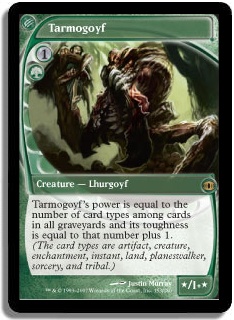 |
vs. |
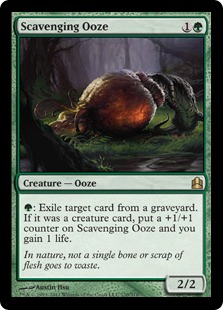 |
“Which one to play?”
The answer so far as I can tell is that the longer and more grinding the game plan a deck is trying to force the better the Ooze gets, while the more aggressive and tempo oriented the game plan one is trying to force, Tarmogoyf becomes better. It is interesting that in the early and midgame Tarmogoyf trumps Scavenging Ooze, but if the game goes long and the Ooze can begin to systematically munch away card types from player’s graveyards, the Ooze will eventually trump the Goyf!
These kinds of little debates, decisions, and in-game battles are what makes Magic (and particularly Vintage) so cool!
III. The Yawgmoth’s Will Decks (Turbo Tezzeret, Drain Tendrils, Vintage Highlander Control)
Moving along to the next deck; another familiar name playing his familiar deck:
Creatures (1)
Planeswalkers (3)
Lands (13)
Spells (43)
- 2 Sensei's Divining Top
- 1 Brainstorm
- 3 Mana Drain
- 1 Vampiric Tutor
- 1 Mystical Tutor
- 2 Grim Monolith
- 1 Yawgmoth's Will
- 4 Force of Will
- 1 Mana Vault
- 1 Sol Ring
- 1 Demonic Tutor
- 1 Hurkyl's Recall
- 1 Transmute Artifact
- 1 Time Walk
- 1 Ancestral Recall
- 1 Mana Crypt
- 4 Gush
- 1 Time Vault
- 1 Merchant Scroll
- 1 Echoing Truth
- 1 Tinker
- 2 Voltaic Key
- 1 Black Lotus
- 1 Lotus Petal
- 1 Mox Jet
- 1 Mox Sapphire
- 1 Ponder
- 1 Spell Pierce
- 2 Mental Misstep
- 2 Flusterstorm
Sideboard

Pretty much the standard big mana blue Tezzeret deck, nothing new or interesting to talk about here—
“Jones’ Turbo Tezz is the second deck in the Grudge Match Top 8 with four Gush and NO Fastbond.”
Wait, what!? Well this is new…
When I was looking at the list, I almost didn’t notice this spicy little innovation as I moved from one expected card choice to the next and nearly glossed over four copies of Gush.
I expect that Jones is playing Gush simply try and reach the critical mass of finding Voltaic Key and Time Vault as quickly as possible. Being able to see two more cards on turn 2 or 3 would definitely increase one’s chances of having the combo with protection more quickly than if he was drawing cards the fair way by using his mana to cast draw spells.
With that being said (and please note that I think having four Gush in this deck is a fantastic strategic move), I think that if Turbo Tezz is already going to be playing with Yawgmoth’s Will and all of the powerful Tutors that splashing green for Fastbond must make this list better. Having Fastbond simply gives the deck another way to go bigger and faster than one’s opponent.
My first inclination would be to cut this spicy number that he’s also jamming:
“I already invented Transmute in SCV a while back, but Jones certainly gets to add his name to a sparse list of Vintage card slingers who have had the privilege to cast this Antiquities card under tournament conditions!”
Jones’ deck is on a mission: make more mana than his opponent and get Voltaic Key and Time Vault into play as quickly and consistently as possible to take all of the rest of the turns. A respectable combination for sure, as lots of mana is excellent as is a game-ending two-card combo.
Transmute Artifact is cool and tech and all, but it is assuredly no Fastbond in a deck that plays four Gush and all the Tutors!
“Would play this in a deck with 4x Gush, Tutors, and Yawgmoth’s Will.”
So far, five completely different and unique decks; let’s see if this trend continues:
YES!
Creatures (3)
Planeswalkers (1)
Lands (15)
Spells (41)
- 1 Tendrils of Agony
- 1 Brainstorm
- 3 Mana Drain
- 1 Vampiric Tutor
- 1 Yawgmoth's Will
- 4 Force of Will
- 4 Accumulated Knowledge
- 1 Sol Ring
- 1 Demonic Tutor
- 1 Time Walk
- 1 Ancestral Recall
- 1 Mana Crypt
- 2 Intuition
- 1 Gifts Ungiven
- 1 Merchant Scroll
- 1 Thirst for Knowledge
- 1 Echoing Truth
- 1 Chain of Vapor
- 1 Tinker
- 1 Rebuild
- 1 Black Lotus
- 1 Mox Emerald
- 1 Mox Jet
- 1 Mox Pearl
- 1 Mox Ruby
- 1 Mox Sapphire
- 1 Mindbreak Trap
- 2 Preordain
- 2 Mental Misstep
- 1 Flusterstorm

John’s Drain Tendrils deck takes me back to the good old days, as its design and tactics take a page right out of the Gifts and Intuition Tendrils decks of yesteryear.
First things first:
“FOUR. PERIOD. NOBODY DRAWS MORE CARDS THAN THIS MAN.”
Basically, Lessard’s deck hangs out and uses permission to dictate the flow and pace of the game while trying to build to a critical mass where it can simply go broken and end the game with one of its two combos: spells + Tendrils of Agony or Tinker, Time Walk, + Blightsteel Colossus.
Both plans are efficiently and effectively fueled by Yawgmoth’s Will, a card that has at least recently become a much less popular strategy in the creature metagame.
John’s deck has a lot of permission to stave off the permission and shenanigans of opposing blue decks, and with Accumulated Knowledge + Snapcaster Mage in the deck is pretty much guaranteed to have inevitability with regard to drawing more cards than an opponent through the midgame.
Lots of basic Islands make this deck pretty solid against Wasteland, which is big with Workshops and Fish floating around. Yet my suggestion for this deck is the noticeable lack of Thoughtseize anywhere in the 75.
“Thoughtseize is seemingly tailor-made for Drain Tendrils decks in Vintage.”
Especially with Snapcasters to rebuy, Thoughtseize to clear the way and ensure one’s “big turn” goes according to plan seems like a really nice insurance policy; not to mention, being able to slow down opposing Gush decks (which look to goldfish a little bit faster than Drain Tendrils) also seems like something worth doing while drawing a ton of cards with A.K.
It’s food for thought…
The next deck, Rob Edwards’ Vintage control, is only a narrative short of being a novel!
Creatures (6)
Planeswalkers (2)
Lands (18)
Spells (34)
- 1 Sensei's Divining Top
- 1 Brainstorm
- 2 Mana Drain
- 1 Vampiric Tutor
- 1 Mystical Tutor
- 1 Yawgmoth's Will
- 4 Force of Will
- 1 Balance
- 1 Sol Ring
- 1 Demonic Tutor
- 1 Time Walk
- 1 Ancestral Recall
- 1 Mana Crypt
- 1 Time Vault
- 1 Gifts Ungiven
- 1
- 1 Merchant Scroll
- 1 Thirst for Knowledge
- 1 Tinker
- 1 Voltaic Key
- 1 Black Lotus
- 1 Mox Emerald
- 1 Mox Jet
- 1 Mox Pearl
- 1 Mox Ruby
- 1 Mox Sapphire
- 1 Ancient Grudge
- 1 Mindbreak Trap
- 2 Mental Misstep

I really like playing decks like this in Vintage tournaments, as the five-color City of Brass mana base essentially enables the pilot to cherry pick whatever spells they want in their deck and play them all.
Combotastic synergies notwithstanding, Edwards’ deck plays the greatest number of most powerful spells of any deck in the Grudge Match Top 8. Not to mention he also has pretty much the sickest bullets imaginable to swing and take control of any given situation.
“Valuetown definition: see above image.”
Vintage control decks basically operate under the assumption that you sacrifice something in playing with a five-color mana base rooted in City of Brass in order to have the option of playing with the most powerful spells in every color. Insert Jace, the Mind Sculptor into the mix to keep looking at powerful spells and many opponents are going to be in a heap of trouble.
Being able to assemble the powerful combo of Goblin Welder + Gorilla Shaman and also being able to easily support Ancient Grudges against Workshops is pretty relevant with Workshops being a strong performer at the moment.
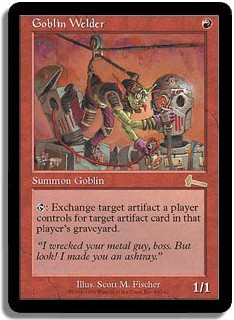 |
+ |
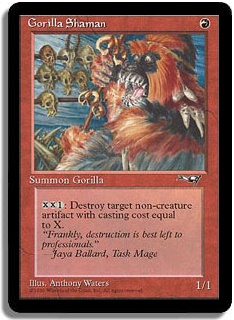 |
“Eat your Mox. Weld your sweet artifact into a Mox. Eat your Mox again. Can and will do this every turn—your move!”
I also heard reports about Rob’s Pernicious Deed (a card that I hadn’t really considered playing for fear of destroying my own artifact mana in VC) being a really effective tool at curtailing Noble Fish and Workshop decks. So that is a neat piece of technology worth thinking about.
IV. Dredge
Rounding out the Top 8 was Michael Kaynes playing a Dredge deck, which essentially provides us with a Top 8 where all of the major pillars of the metagame—Prison, Aggro, Midrange, Combo, Combo-Control, Pure Control, and Graveyard/Reanimator—are present and accounted for!
Creatures (26)
- 3 Ichorid
- 1 Flame-Kin Zealot
- 4 Golgari Grave-Troll
- 2 Golgari Thug
- 4 Stinkweed Imp
- 4 Narcomoeba
- 2 Fatestitcher
- 4 Bloodghast
- 2 Sun Titan
Lands (14)
Spells (20)
- 1 Ancestral Recall
- 4 Cabal Therapy
- 1 Chain of Vapor
- 1 Black Lotus
- 3 Dread Return
- 4 Bridge from Below
- 3 Nature's Claim
- 3 Mental Misstep
Sideboard

It’s a Dredge deck.
Moving on…
Breakout Deck: Griselbrand Oath
Paul Mastriano narrowly missed out on making Top 8 by losing his last round at the Grudge Match playing his new Griselbrand Oath deck. In all honesty, despite not making Top 8 I think that this list is by and large the most important deck to come out of this event. I believe Griselbrand Oath is very likely to be a major player in the metagame moving forward in the months to come.
Creatures (2)
Planeswalkers (2)
Lands (16)
Spells (40)
- 1 Brainstorm
- 1 Fastbond
- 1 Vampiric Tutor
- 1 Mystical Tutor
- 4 Oath of Druids
- 1 Yawgmoth's Will
- 4 Force of Will
- 1 Sol Ring
- 1 Demonic Tutor
- 1 Gaea's Blessing
- 1 Hurkyl's Recall
- 1 Time Walk
- 1 Ancestral Recall
- 4 Gush
- 1 Time Vault
- 1 Merchant Scroll
- 1 Voltaic Key
- 1 Black Lotus
- 1 Mox Emerald
- 1 Mox Jet
- 1 Mox Pearl
- 1 Mox Ruby
- 1 Mox Sapphire
- 2 Thoughtseize
- 4 Preordain
- 1 Beast Within
- 1 Flusterstorm
Sideboard

I talked to Paul after the event, and he said that Oathing up Griselbrand is so much better than any other creature that one could get that it is pretty much not even a contest of which creature to cheat into play. It is now a given.
“There is always a higher power—except in the case of Griselbrand!”
(If you didn’t get that reference: see flavor text of Cruel Ultimatum.)
The goal in this deck is to get a Griselbrand into play, and according to Paul once that happens it is pretty much impossible to lose (so long as you can draw seven). The Oath deck can end the game by attacking with Griselbrand himself, since in addition to being Yawgmoth’s Bargain with lifelink, he also attacks for seven with evasion. You use the slew of free cards to protect him and win the game or by simply assembling and protecting the Key + Vault combo and taking infinite turns.
“I love this card as a one-of in Oath!”
Beast Within should be in every Oath of Druids deck; it’s freaky good technology and yet I still frequently see decks that don’t have it!
I have traditionally disliked Oath of Druids for a variety of reasons: firstly, you have to play bricks in your deck that you will inevitably draw AKA Big Dumb Monsters; secondly, you have to wait a turn to get a return on Oath of Druids; and lastly, I have never believed that there was a creature I wanted that could impact the game enough to make it worth waiting a turn for.
Griselbrand essentially eliminates one of the entire problems I have had with the Oath deck simply by existing. Yes, you still have to wait a turn to get Griselbrand after casting Oath of Druids—but the difference is that he is actually worth the wait because he actually wins the game simply by showing up to the battlefield.
I’m sure that there are ways that one can lose when they put a 7/7, flying, lifelink, Yawgmoth’s Bargain onto the battlefield, but to be fair they are few and far between.
Conclusion And Final Thoughts On Grudge Match V
I think that Tournament Organizer Nick Detwiler summed up Grudge Match V and the current state of Vintage in general very well in the following statement:
“As far as perceptions of the metagame go, I think the salient point was (to reiterate) the diversity. Rituals, Drains, Shops, Bazaars, and Null Rods were all really well represented. Rituals put two players in the Top 16, Drains put a bunch of guys in Top 8, Shops won the tournament, Bazaars had a couple of players in Top 16, and Mike Hajduk had a really cool RUG Delver list that made the finals. Everybody showed up, and to some degree everybody had success. If a few breaks went differently we could be talking about a completely different Top 8, and at no point would we be able to call this metagame oppressive. BTW, it feels like Blightteel is seeing his percentage in the field significantly drop, and that’s absolutely wonderful. Some of the cards that make Vintage feel unfair or not fun are falling by the wayside.”
It is interesting that he remarks about Blightsteel Colossus falling out of popularity, because in the last two Vintage events I played in he made my 60 and I thought he was terrible and regretted playing with him. Also, Paul’s Grudge Match Griselbrand Oath deck had BSC, and he said he actively didn’t make Top 8 because he Oathed up the creature when he wanted Griselbrand and ended up losing. (See what I mean about Oathing up creatures that are actually worth getting…)
Swords to Plowshares and Jace, the Mind Sculptor have played a big part in curtailing the tyranny of Big Bad Blighty, which is most certainly a good and healthy direction for Vintage.
All in all, a lot of really cool and diverse decks showed up at the Grudge Match, and I am really looking forward to some fun and interesting Type I tournaments this summer!
Thanks for reading,
Brian DeMars

